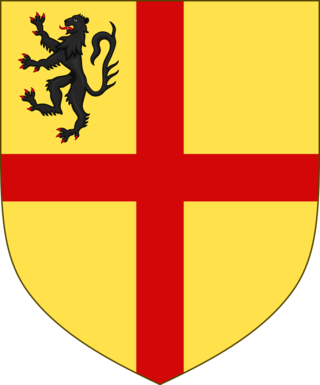
Ruaidrí mac Tairrdelbach Ua Conchobair was King of Connacht from 1156 to 1186, and High King of Ireland from 1166 to 1198. He was the last High King of Ireland before the Anglo-Norman invasion.

Uí Fhiachrach Aidhne was a kingdom located in what is now the south of County Galway.
Conchobar Maenmaige Ua Conchobair, son of High King of Ireland Ruaidrí Ua Conchobair, was King of Connacht from 1183 to 1189. He was a military commander and opponent of the Norman invasion of Ireland.

Cathal Crobhdearg Ua Conchobair (1153–1224), was a king of Connacht. He was the youngest son of the High King of Ireland Tairrdelbach Ua Conchobair and brother to the last fully recognized High King Ruadri Ua Conchobair. His own sons Aedh Ua Conchobair and Feidhlimidh Ua Conchobair were kings of Connacht after him.
Felim McHugh O'Connor was king of Connacht in Ireland from January 1310 to 10 August 1316. The beginning of his kingship saw a revival in the ancient form of inauguration performed for the Kings of Connacht after a period of apparent lapse in the practice. His reign took place against the background of a Gaelic recovery following the Anglo-Norman invasion and the disputed High Kingship of Edwurd Bruce. He was the last King of Connacht to truly hold power over the entire province and his death halted the gains that had been made following the Anglo Norman invasion, by his kingdom. His foster father Maelruanid Mac Diarmata King of Magh Lurg would play an instrumental role in his reign.
Hugh McOwen O'Conor was king of Connacht in late medieval Ireland. He is the person addressed in the poem Cóir Connacht ar chath Laighean and in the poem An tu aris a raith Theamhrach by Aonghus Ruadh Ó Dálaigh.
Toirdelbach Ó Conchobair, anglicised Turlough O'Conor, was one of a number of claimants to the kingship of Connacht in the disastrous aftermath of the Second Battle of Athenry. He overthrew Rory na BhFeadh but was himself overthrown in 1318.
Hugh McHugh Breifne O'Conor was king of Connacht, Ireland, in 1342. He was the last of the Clan Murtagh O'Conor to hold this position. He died in 1350, as the O'Connor Breifne, some eight years after being expelled. His father, a son of Cathal O'Connor had briefly made a bid for the kingship in 1309-10 from a power-base established in Breifne O'Rourke.
Ruaidri mac Tairdelbach Ua Conchobair, King of Connacht, died 1384. The previous king though not listed was slain and defeated by the Ó Cellaigh's of Ui Maine.

The O'Conordynasty are an Irish noble dynasty and formerly one of the most influential and distinguished royal dynasties in Ireland. The O'Conor family held the throne of the Kingdom of Connacht up until 1475. Having ruled it on and off since 967, they ruled continuously from 1102 to 1475. Moreover, the O'Conor parent house the Uí Briúin and Síol Muireadaigh ruled Connacht on many occasions – but not continuously – between 482 and 956. The house of O'Conor also produced two High Kings of Ireland, Tairrdelbach Ua Conchobair and his son Ruaidrí Ua Conchobair, the last High King of Ireland. The family seat is Clonalis House outside Castlerea in County Roscommon.
Ó Maolchonaire, more properly Ó Maol Chonaire, sometimes Ó Mhaoilchonaire, Ó Maolconaire, etc., was the surname of a family of professional poets and historians in medieval Ireland. Traditionally it would have been spelled without the 'h', but with a dot over the 'c', either of which indicatesaspiration. In a period prior to the surrender of the Ó Conchubhair Donn and the other Connacht chieftains, it was anglicised O'Mulconry; however, the family was required to drop the national prefixes as part of the terms of surrender. Specific families, particularly the educators, were systematically targeted as part of the plot to destroy the Irish culture and language, as well as the Catholic religion. This can add great confusion to researchers of this important literary and religious family. It is now rendered most commonly Conry, sometimes Conroy, and possibly sometimes King. There are many distinct groups of Conroys, some of whom also, though less commonly, use Conry, which are Anglicisations of disparate Irish Gaelic names.
Cathal mac Conchobair was King of Connacht.
Events from the year 1338 in Ireland.
Events from the year 1337 in Ireland.
Tadg mac Conchobair was a King of Connacht from the Uí Briúin branch of the Connachta. He was the son of Conchobar mac Taidg Mór, a previous king, the second of his three sons to rule in succession, succeeding his brother Áed mac Conchobair. He was of the Síl Muiredaig sept of the Uí Briúin. He ruled from 888-900.
Owen Ó hEidhin was King of Uí Fiachrach Aidhne.
Donn Óge Mag Oireachtaigh was the lord of Clann Taidg.

Umhaill or Umhall was a Gaelic territory around Clew Bay in the west of what is now County Mayo, Ireland, comprising the baronies of Burrishoole and Murrisk. By the 12th century, its ruling dynasty were known as the Uí Máille (O'Malleys). Originally an autonomous part of the kingdom of Connacht, it later became one of the vassal territories of the Mac William Íochtar. Umhaill's last and most famous ruler was Grace O'Malley, nicknamed "the pirate queen". In 1576, during the Tudor conquest of Ireland, she agreed to the surrender and regrant policy, accepting English inheritance law in return for official title deeds to her lands. On her death the lands were inherited by her son Tibbot "na Long". Umhaill had a strong seafaring culture. Important sites associated with it include Carrickkildavnet Castle, Carrickahowley Castle, Granuaile's Castle and Clare Island Abbey.
Toirdhealbhach Ó Conchobhair was a King of Connacht.

Ulick Fionn Burke, 6th Clanricarde or Mac William Uachtar was an Irish chieftain and noble.





